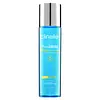What's inside
What's inside
 Key Ingredients
Key Ingredients

 Benefits
Benefits

 Concerns
Concerns

No concerns
 Ingredients Side-by-side
Ingredients Side-by-side

Water
Skin ConditioningGlycerin
HumectantPentylene Glycol
Skin ConditioningAcrylates/C10-30 Alkyl Acrylate Crosspolymer
Emulsion StabilisingPPG-26-Buteth-26
Skin ConditioningAllantoin
Skin ConditioningChlorphenesin
AntimicrobialPEG-40 Hydrogenated Castor Oil
EmulsifyingSodium Benzoate
MaskingBis-PEG-18 Methyl Ether Dimethyl Silane
EmollientCarrageenan
O-Cymen-5-Ol
AntimicrobialSodium Hydroxide
BufferingPropylene Glycol
HumectantTetrasodium EDTA
Pelargonium Graveolens Flower Oil
MaskingHydrolyzed Algin
Citronellol
PerfumingGeraniol
PerfumingLinalool
PerfumingMaris Aqua
HumectantCassia Angustifolia Seed Polysaccharide
Skin ConditioningCitric Acid
BufferingChlorella Vulgaris Extract
Skin ConditioningPhenoxyethanol
PreservativeHypericum Perforatum Extract
AntimicrobialAnthemis Nobilis Flower Extract
MaskingCalendula Officinalis Flower Extract
MaskingCentaurea Cyanus Flower Extract
AstringentChamomilla Recutita Flower Extract
MaskingTilia Cordata Flower Extract
Skin ConditioningHydroxyethylcellulose
Emulsion StabilisingBHT
AntioxidantWater, Glycerin, Pentylene Glycol, Acrylates/C10-30 Alkyl Acrylate Crosspolymer, PPG-26-Buteth-26, Allantoin, Chlorphenesin, PEG-40 Hydrogenated Castor Oil, Sodium Benzoate, Bis-PEG-18 Methyl Ether Dimethyl Silane, Carrageenan, O-Cymen-5-Ol, Sodium Hydroxide, Propylene Glycol, Tetrasodium EDTA, Pelargonium Graveolens Flower Oil, Hydrolyzed Algin, Citronellol, Geraniol, Linalool, Maris Aqua, Cassia Angustifolia Seed Polysaccharide, Citric Acid, Chlorella Vulgaris Extract, Phenoxyethanol, Hypericum Perforatum Extract, Anthemis Nobilis Flower Extract, Calendula Officinalis Flower Extract, Centaurea Cyanus Flower Extract, Chamomilla Recutita Flower Extract, Tilia Cordata Flower Extract, Hydroxyethylcellulose, BHT
Sodium Hyaluronate
HumectantHydrolyzed Hyaluronic Acid
HumectantWater
Skin ConditioningGlycerin
HumectantDipropylene Glycol
HumectantTranexamic Acid
AstringentButylene Glycol
HumectantDiglycerin
HumectantPEG-8
HumectantPEG-6
HumectantPEG-32
HumectantStyrene/Vp Copolymer
Polysorbate 20
EmulsifyingHydroxylated Lecithin
EmulsifyingCitric Acid
BufferingTocopherol
AntioxidantMagnesium Ascorbyl Phosphate
AntioxidantPentylene Glycol
Skin ConditioningPhenoxyethanol
PreservativeDipotassium Glycyrrhizate
HumectantDisodium EDTA
Sodium Hyaluronate, Hydrolyzed Hyaluronic Acid, Water, Glycerin, Dipropylene Glycol, Tranexamic Acid, Butylene Glycol, Diglycerin, PEG-8, PEG-6, PEG-32, Styrene/Vp Copolymer, Polysorbate 20, Hydroxylated Lecithin, Citric Acid, Tocopherol, Magnesium Ascorbyl Phosphate, Pentylene Glycol, Phenoxyethanol, Dipotassium Glycyrrhizate, Disodium EDTA
 Reviews
Reviews

Alternatives
Ingredients Explained
These ingredients are found in both products.
Ingredients higher up in an ingredient list are typically present in a larger amount.
Citric Acid is an alpha hydroxy acid (AHA) naturally found in citrus fruits like oranges, lemons, and limes.
Like other AHAs, citric acid can exfoliate skin by breaking down the bonds that hold dead skin cells together. This helps reveal smoother and brighter skin underneath.
However, this exfoliating effect only happens at high concentrations (20%) which can be hard to find in cosmetic products.
Due to this, citric acid is usually included in small amounts as a pH adjuster. This helps keep products slightly more acidic and compatible with skin's natural pH.
In skincare formulas, citric acid can:
While it can provide some skin benefits, research shows lactic acid and glycolic acid are generally more effective and less irritating exfoliants.
Most citric acid used in skincare today is made by fermenting sugars (usually from molasses). This synthetic version is identical to the natural citrus form but easier to stabilize and use in formulations.
Read more about some other popular AHA's here:
Learn more about Citric AcidGlycerin is already naturally found in your skin. It helps moisturize and protect your skin.
A study from 2016 found glycerin to be more effective as a humectant than AHAs and hyaluronic acid.
As a humectant, it helps the skin stay hydrated by pulling moisture to your skin. The low molecular weight of glycerin allows it to pull moisture into the deeper layers of your skin.
Hydrated skin improves your skin barrier; Your skin barrier helps protect against irritants and bacteria.
Glycerin has also been found to have antimicrobial and antiviral properties. Due to these properties, glycerin is often used in wound and burn treatments.
In cosmetics, glycerin is usually derived from plants such as soybean or palm. However, it can also be sourced from animals, such as tallow or animal fat.
This ingredient is organic, colorless, odorless, and non-toxic.
Glycerin is the name for this ingredient in American English. British English uses Glycerol/Glycerine.
Learn more about GlycerinPentylene glycol is typically used within a product to thicken it. It also adds a smooth, soft, and moisturizing feel to the product. It is naturally found in plants such as sugar beets.
The hydrophilic trait of Pentylene Glycol makes it a humectant. As a humectant, Pentylene Glycol helps draw moisture from the air to your skin. This can help keep your skin hydrated.
This property also makes Pentylene Glycol a great texture enhancer. It can also help thicken or stabilize a product.
Pentylene Glycol also acts as a mild preservative and helps to keep a product microbe-free.
Some people may experience mild eye and skin irritation from Pentylene Glycol. We always recommend speaking with a professional about using this ingredient in your routine.
Pentylene Glycol has a low molecular weight and is part of the 1,2-glycol family.
Learn more about Pentylene GlycolPhenoxyethanol is a preservative that has germicide, antimicrobial, and aromatic properties. Studies show that phenoxyethanol can prevent microbial growth. By itself, it has a scent that is similar to that of a rose.
It's often used in formulations along with Caprylyl Glycol to preserve the shelf life of products.
Water. It's the most common cosmetic ingredient of all. You'll usually see it at the top of ingredient lists, meaning that it makes up the largest part of the product.
So why is it so popular? Water most often acts as a solvent - this means that it helps dissolve other ingredients into the formulation.
You'll also recognize water as that liquid we all need to stay alive. If you see this, drink a glass of water. Stay hydrated!
Learn more about Water